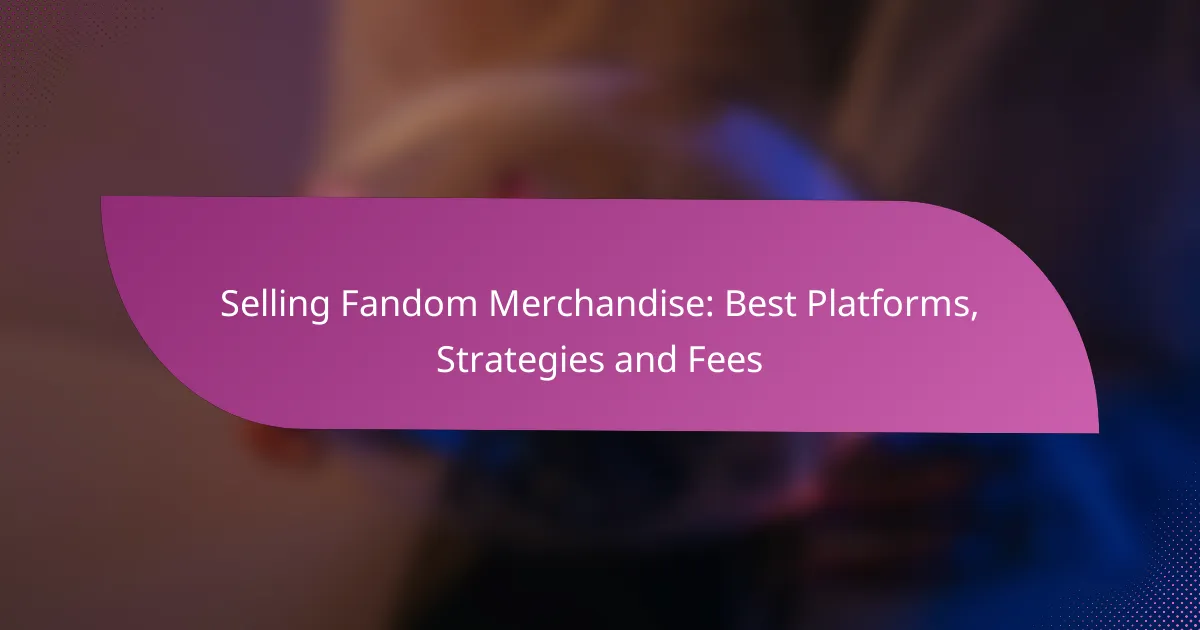Selling fandom merchandise can be a lucrative venture, but choosing the right platform is key to success. Popular options like Etsy, Shopify, Redbubble, Amazon, and eBay each offer distinct features and fee structures that cater to different audiences. To boost sales, it’s important to implement targeted marketing strategies that engage your fanbase and understand the fees involved to protect your profit margins.
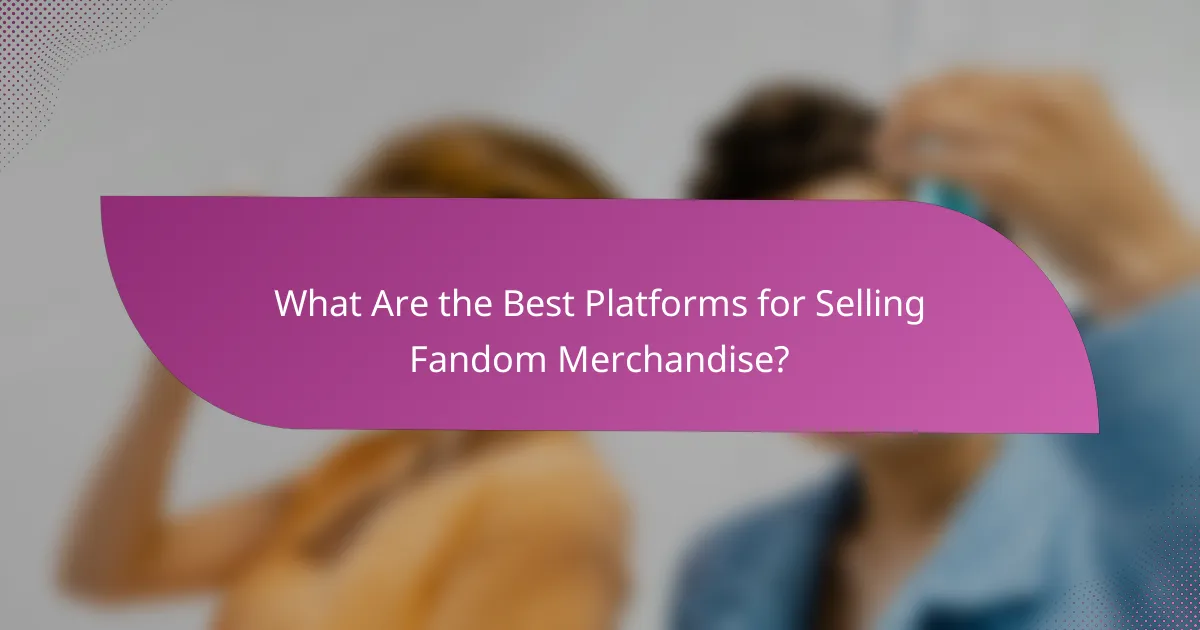
What Are the Best Platforms for Selling Fandom Merchandise?
The best platforms for selling fandom merchandise include Etsy, Shopify, Redbubble, Amazon, and eBay. Each platform has unique features, fees, and audiences, making it essential to choose one that aligns with your products and business goals.
Etsy
Etsy is ideal for handmade and vintage fandom merchandise, attracting a niche audience that appreciates unique items. Sellers can create customized shops, allowing for personal branding and direct customer engagement.
Consider the listing fees, which are typically low, but Etsy charges a transaction fee on sales. It’s crucial to optimize your product listings with relevant keywords to improve visibility.
Shopify
Shopify is a robust e-commerce platform that allows you to build a fully customizable online store for your fandom merchandise. It offers various themes and apps to enhance functionality and design.
While Shopify has a monthly subscription fee, it provides tools for managing inventory, payments, and shipping. This platform is suitable for those looking to scale their business and maintain full control over branding and customer experience.
Redbubble
Redbubble is a print-on-demand service that allows artists to upload designs and sell them on various products, from t-shirts to stickers. This platform is perfect for creators who want to focus on design without handling inventory or shipping.
Redbubble takes a percentage of each sale, so it’s important to set competitive prices while ensuring a profit margin. The platform also has a built-in audience, which can help increase visibility for your designs.
Amazon
Amazon offers a massive marketplace for selling fandom merchandise, providing access to millions of potential customers. Sellers can list products through Amazon’s Fulfillment by Amazon (FBA) service, which handles storage, shipping, and customer service.
However, Amazon charges various fees, including referral and fulfillment fees, which can add up. It’s essential to research your competition and optimize your listings to stand out in a crowded marketplace.
eBay
eBay is a well-known platform for selling new and used fandom merchandise through auctions or fixed-price listings. It allows sellers to reach a global audience and offers flexibility in pricing strategies.
Be aware of eBay’s listing and final value fees, which can vary based on the category of your merchandise. Effective product descriptions and clear images are crucial for attracting buyers and driving sales.
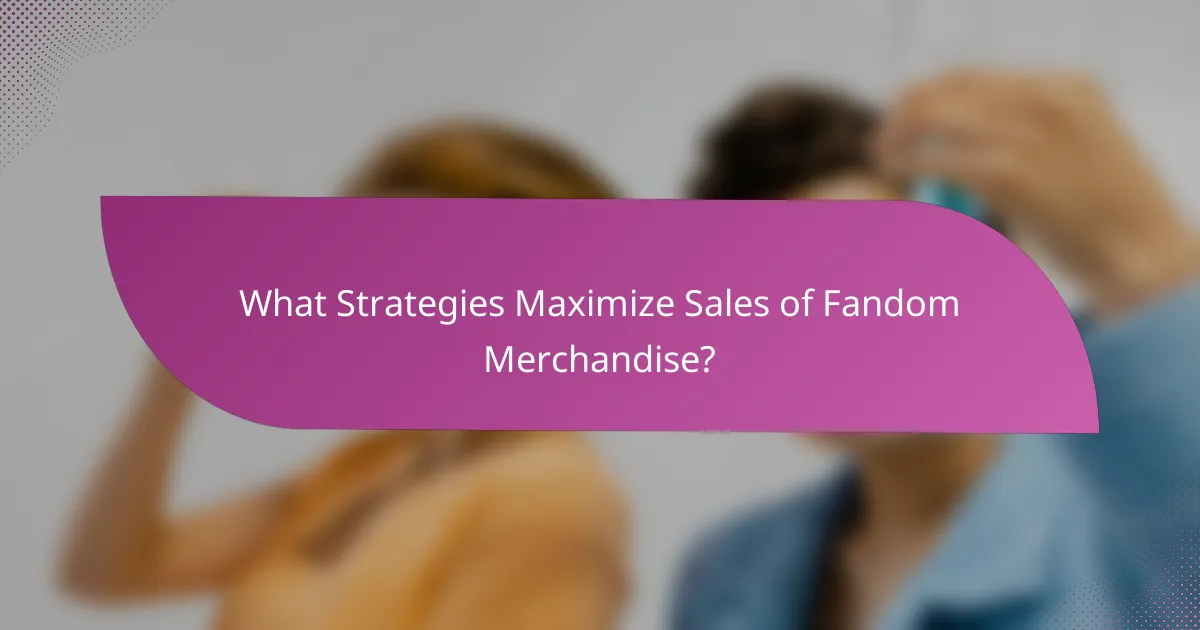
What Strategies Maximize Sales of Fandom Merchandise?
To maximize sales of fandom merchandise, focus on engaging your audience through targeted marketing strategies, leveraging social media, influencer partnerships, and effective content creation. Each approach should be tailored to resonate with your specific fanbase and drive conversions.
Social Media Marketing
Social media marketing is essential for reaching fandom audiences where they spend their time. Platforms like Instagram, Facebook, and TikTok allow you to showcase products visually and interact directly with fans. Regularly posting engaging content, such as behind-the-scenes looks or fan polls, can significantly boost visibility and sales.
Consider using paid ads to target specific demographics, ensuring your merchandise reaches the right audience. Monitor engagement metrics to refine your strategy and focus on posts that generate the most interest.
Influencer Collaborations
Collaborating with influencers who share your fandom can effectively expand your reach. These influencers already have established trust with their followers, making their endorsements valuable. Choose influencers whose audience aligns with your target market to ensure authenticity and relevance.
When planning collaborations, consider offering exclusive merchandise or discounts to their followers. This not only incentivizes purchases but also creates a sense of urgency that can drive sales quickly.
SEO Optimization
SEO optimization is crucial for increasing the visibility of your online store. Use relevant keywords related to your fandom merchandise in product descriptions, blog posts, and metadata to improve search engine rankings. Tools like Google Keyword Planner can help identify popular search terms.
Additionally, focus on creating high-quality content that answers common questions or provides value to your audience. This can enhance your site’s authority and attract organic traffic, ultimately leading to higher sales.
Content Marketing
Content marketing involves creating valuable content that engages your audience and promotes your merchandise. This can include blog posts, videos, or podcasts that discuss fandom topics, trends, or product reviews. By providing entertaining or informative content, you build a loyal community around your brand.
Incorporate calls to action within your content, directing readers to your merchandise. Regularly updating your content not only keeps your audience engaged but also helps with SEO, driving more traffic to your site over time.

What Are the Fees Associated with Selling on These Platforms?
When selling fandom merchandise on various platforms, it’s crucial to understand the associated fees, as they can significantly impact your profit margins. Each platform has its own fee structure, including listing fees, transaction fees, and subscription costs, which can vary widely.
Etsy Fees
Etsy charges a listing fee of $0.20 per item, which is valid for four months or until the item sells. Additionally, sellers incur a transaction fee of around 6.5% on the sale price, plus a payment processing fee that typically ranges from 3% to 4% based on the total sale amount. It’s essential to factor these costs into your pricing strategy to maintain profitability.
Shopify Subscription Costs
Shopify operates on a subscription model with plans starting at approximately $29 per month for the Basic plan. This fee grants access to the platform’s features, but additional transaction fees apply if you do not use Shopify Payments, which can be around 2% per transaction. Consider your sales volume to determine if a higher-tier plan may offer better value.
Redbubble Commission Structure
Redbubble allows artists to set their own profit margins on products, but the base price is determined by Redbubble, which includes production and operational costs. Typically, artists earn a commission of around 20% to 30% above the base price. Understanding this structure helps you price your merchandise effectively while ensuring a fair profit.
Amazon Seller Fees
Amazon charges various fees depending on the selling plan. Individual sellers pay a per-item fee of $0.99, while professional sellers pay a monthly subscription fee of about $39.99. Additionally, Amazon takes a referral fee that ranges from 6% to 45% of the sale price, depending on the category. Be sure to evaluate these fees against your expected sales volume to choose the most cost-effective plan.
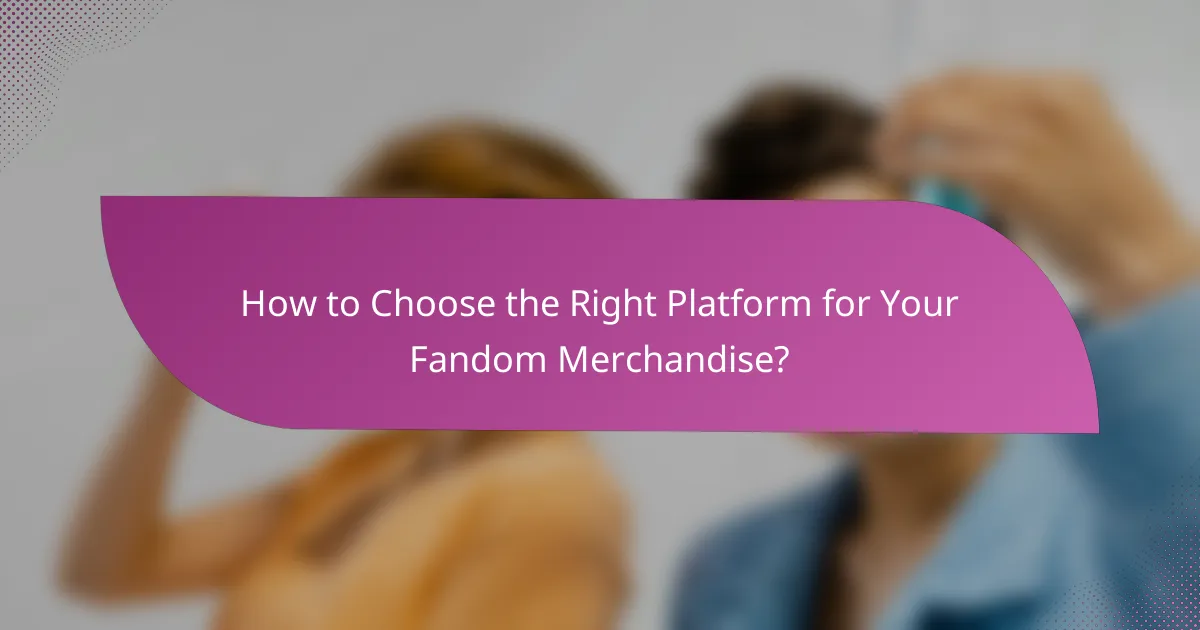
How to Choose the Right Platform for Your Fandom Merchandise?
Selecting the right platform for selling fandom merchandise involves understanding your target audience, the types of products you offer, and the associated fees. Each platform has unique features that cater to different niches, so it’s essential to align your choice with your business goals and customer preferences.
Target Audience Considerations
Identifying your target audience is crucial when choosing a platform for fandom merchandise. Consider demographics such as age, interests, and spending habits. For instance, platforms like Etsy may attract a younger, creative crowd, while eBay might appeal to collectors looking for rare items.
Engage with your audience through social media or forums to understand their preferences. This feedback can guide you in selecting a platform that resonates with your fanbase, ensuring better engagement and sales.
Product Type Compatibility
The type of merchandise you sell significantly influences your platform choice. Some platforms are better suited for handmade or unique items, while others excel in mass-produced goods. For example, Shopify is ideal for custom merchandise, while Amazon is better for high-volume sales of popular fandom items.
Evaluate the specific requirements of your products, such as size, shipping needs, and customization options. Ensure the platform supports these features to streamline your selling process and enhance customer satisfaction.
Fee Structure Analysis
Understanding the fee structure of each platform is essential for profitability. Most platforms charge listing fees, transaction fees, and payment processing fees, which can vary widely. For example, Etsy charges around 5% on sales, while Amazon’s fees can range from 15% to 20% depending on the category.
Calculate potential costs based on your expected sales volume to determine which platform offers the best value. Avoid platforms with hidden fees that could eat into your profits, and consider starting with a platform that has lower upfront costs to test your merchandise.
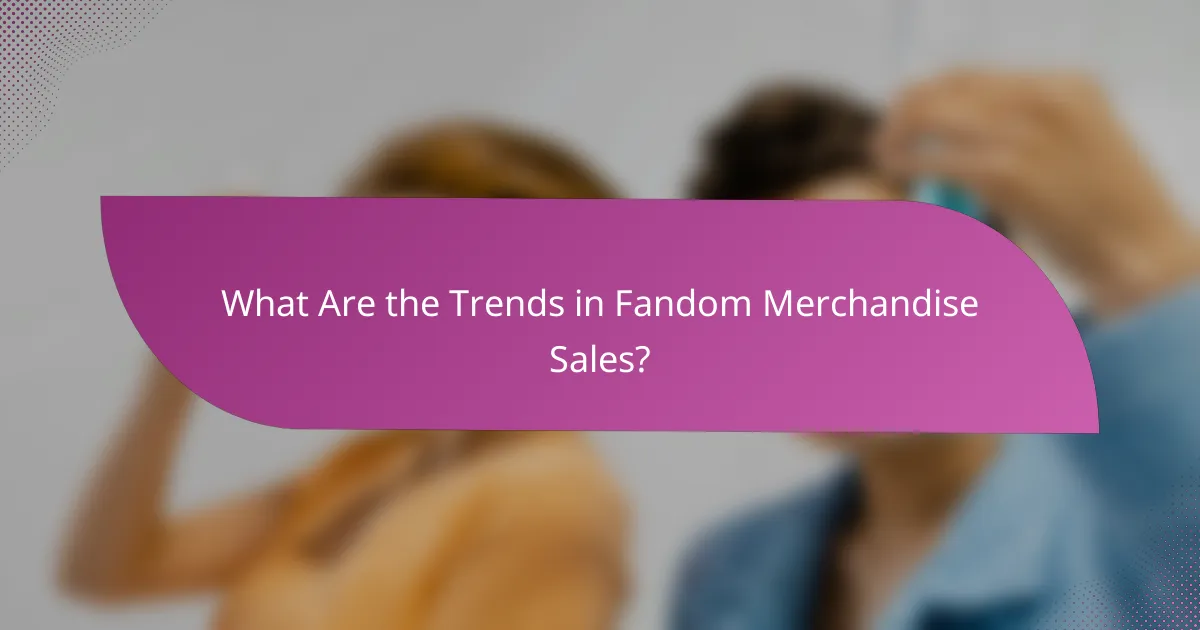
What Are the Trends in Fandom Merchandise Sales?
Fandom merchandise sales are increasingly driven by personalization and sustainability. Fans are looking for unique, custom items that reflect their interests, while also prioritizing eco-friendly options that align with their values.
Rise of Custom Merchandise
Custom merchandise is becoming a popular choice among fans who want to express their individuality. Platforms like Etsy and Redbubble allow creators to design and sell personalized items, from clothing to home decor, catering to niche fandoms.
When selling custom merchandise, consider using print-on-demand services to minimize upfront costs and inventory risks. This model allows you to offer a wide variety of designs without the financial burden of bulk production.
Be mindful of the quality of materials and printing methods, as fans often seek high-quality products that reflect their passion. Engaging with your audience through social media can also help you understand their preferences and tailor your offerings accordingly.
Increased Demand for Eco-Friendly Products
There is a growing trend towards eco-friendly merchandise among fans who are conscious of environmental issues. Products made from sustainable materials, such as organic cotton or recycled plastics, are gaining traction in the market.
To meet this demand, consider sourcing merchandise from suppliers who prioritize sustainability. Highlighting eco-friendly practices in your marketing can attract environmentally conscious consumers and differentiate your brand.
Additionally, be transparent about your production processes and the materials used. This builds trust with your audience and aligns your brand with their values, potentially leading to increased sales and loyalty.
